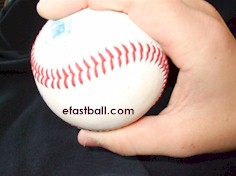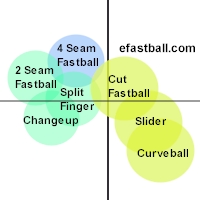How to Grip a Cut Fastball (Cutter)



Cut Fastball

Right Handed Pitcher
Updates
- 3/5/2010 - Added MLB cutter speed, plus clarified how a cutter is different from a fastball, curve, and slider.
- 5/08 initial page
AKA
This grip is also called a cutter or a cut fastball.Hybrid
A cutter is held like a curve or slider but is released like a fastball. This makes the ball go right/left in the opposite direction from a fastball (see 'Hitter's View' chart below)Position the Ball
Similar to 2 seam fastball position, but with a curve/slider grip Turn the ball where the horseshoes (the "U") are close together and run the direction of your fingers. The closed part of the horseshoe points to your thumb and the open part points to the pinky.Position your fingers
Place your first two fingers (index and middle) just inside and next to the right hand seam.Position your thumb
Place your thumb directly under the ball on the smooth part of the baseball (no seam).Exert Pressure
Squeeze the ball with your thumb pushing against your middle finger.Delivery and Release
Push your middle finger toward the batter. Your hand will pronate (thumb down, inward, clockwise LH, counterclockwise RH) slightly.This pitch is released/pronated the same as a four seam or two seam fastball, which is the opposite release of a curveball.
Compared to other grips
A cutter is a type of fastball and is almost as fast, but it moves in the opposite direction. It's speed is between a fastball and a slider and the ball should break just before it reaches the hitter.What the hitter sees
This ball appears as a two seam fastball (or four seamer if using the 4 seam grip).The two seams appear to the hitter as two off-center vertical lines.
The hitter thinks 2 seamer and then the ball moves in the opposite horizontal direction from what he expects.
Alternate grip
Move the fingers to the left seam. Or use a four seam grip and lay your first two fingers to either side.When to throw
This is not a common pitch. It is difficult to locate. If it hangs (doesn't move left or right) it can be hit.Throw it up and inside to a LH batter to break their bat. Throw low and away to a RH batter. reverse for LH pitcher
What it does (movement)
The ball will move to the left (RH pitcher) a few inches but will not drop like a slider or curve ball.When this pitch thrown at the hands by a RH pitcher to a LH batter (or LH pitcher to RH batter), it can crack the bat, since it will hit the handle.
Reaction Time
The hitter has roughly 0.40 seconds to hit this pitch.Typical Speed
This pitch is slightly slower (average 4 mph slower in MLB) than a normal 2 or 4 seam fastball.| 10 and under | 40-50 mph |
| 11-12 | 50-60 mph |
| 13-14 | 55-75 mph |
| High School | 75-85 mph |
| College/ Pro | 80-90 mph |
The average speed of a cut fastball in the majors is 86-87 mph.
The ball will typically slow down 8-10 mph by the time it reaches the front of the plate. (Note that your home radar gun may stop reading well before the ball reaches the plate because the hitter is in the way.)
